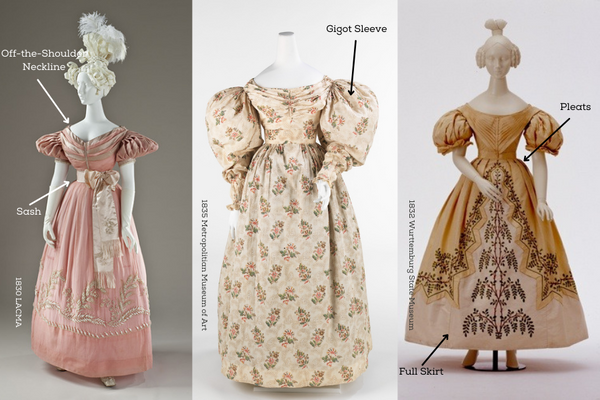
We’ve put together the ultimate guide to help you make a historically accurate early Victorian period look for your 18-inch and other size dolls! The Victorian era lasted from the 1830s until 1901 (when the Edwardian era began). This style guide will cover from the 1830s through the 1860s as styles stayed somewhat similar during this time period (watch for our part two article about the later years of Victorian fashion, coming soon).
The Victorian era was named after the British Queen Victoria, who reigned from 1837 to 1901.
Fun Fact: up until 2015 she was the longest reigning British monarch of all time and is still today the tenth longest reigning monarch in all of world history.
The fashion of the early Victorian period was defined by full skirts, poufy sleeves, and tight corsets all of which were set into style by the Queen herself. Victoria’s influence on fashion not only stretched across the Commonwealth but also over to the United States as well, especially on the East Coast where America was on the brink of the Civil War.
1830s

The 1830s is the earliest period in Victorian fashion and it diverted quite a bit from the previous several decades. Since the change of the eighteenth to the nineteenth century, women’s dresses became smaller with less volume. The 1830s reintroduced volume and excess in women’s fashion. This can be seen through the popularization of the gigot Sleeve, which is a French word referring to the back leg of an animal. It is an edited version of a leg-o-mutton sleeve where the sleeve is wide and voluminous at the top but narrow at the bottom.
Skirts of dresses featured many pleats, embellishments starting around the kneeline, and hems that ended at the ankles. Bodices had off-the-shoulder necklines, were tight, and ended slightly below the waist in a point. They were nearly always accentuated with sashes, belts, or other ties. Evening and formal dresses would resemble day dresses in silhouette but would often feature shorter sleeves that were still puffed and more decorations. To finish the look, the most women would wear their hair parted down the middle and tightly pulled back into a low bun with ringlets surrounding their faces and sometimes falling over their buns. To try it yourself, you can check out this tutorial.
1840s

The 1840s stayed somewhat similar to the 1830s in terms of style and fashion. One of the main differences was the change in bodice style. Dress bodices still ended slightly below the waist at a point. They were now worn with a higher neckline that ended with a collar or sometimes a shallow v-neck that modestly did not show any cleavage. The armscye was dropped and started lower off of the true shoulder line than before with less dramatic sleeves. Sleeves were still large and slimmed at the cuffs, but their volume was now distributed more evenly than in the 1830s. Long sleeves were worn for day dresses and short sleeves were worn for formal wear. The hems on the skirts of dresses dropped back down to the ground during this decade as well. It is also important to note that starting in the 1840s skirts became progressively fuller until the 1860s where the plateaued for a bit, then they shrunk back down starting in the 1870s.
The popular Hairstyle stayed fairly similar to the 1830s except instead of ringlets framing the face, the face was now surrounded by tight braids that looped below the ears (you can try it yourself using this tutorial). It is also interesting to note how much clothing women wore at once during the 1840s and 1850s specifically. Women wore up to five layers of clothing daily that consisted of a dozen individual pieces: a chemise, a corset, bloomers, stockings, petticoats (sometimes multiple petticoats), a crinoline (also known as a hoop skirt), a dress (which could be up to two pieces, see below), sleeves (separate from the sleeves attached to the bodice), a shawl, a bonnet, gloves, and a parasol.
1850s

In the 1850s hems on dresses raised once again back to the ankles or slightly above. Day dresses were still worn featuring tight bodices and full sleeves, but the sleeves changed shape during this era. Popular sleeve styles included bell, bishop, and pagoda sleeves. Each of these sleeve types were different from the previous decades because they did not lose their fullness near the wrist, in fact, they grew larger towards the wrists. Lace collars on the necklines of dresses were popularized during this time. A new trend in women’s fashion that appeared were jackets and jacket type bodices. Jackets at this time usually had pagoda-style sleeves with a v-shape opening in the front to expose the bodice underneath. They closed near the collar usually with only one fastener which was most likely either a tie, a frog clasp, or a hook-and-eye. Jackets most often were worn cropped and ended at the waistline on gowns. Another interesting innovation in the 1850s was the introduction of two-piece dresses. These were still considered to be dresses although they contained two parts: a bodice and a skirt. Most women had two or more bodices per skirt that were all made from the same fabric. This made it so the same dress could be worn for multiple occasions just by changing the bodice.
1860s

The main evolution in womenswear in the 1860s was the introduction of the Garibaldi blouse. These blouses were looser bodices that had large, loose, low-starting sleeves. They were usually collarless with buttons running up the front or the back as a closure. This is one of the first instances where buttons were chosen over laces for a closure. Skirt styles stayed the similar to the previous decade. In America, the 1860s were dominated by the Civil War, which had a direct influence on fashion, as most world events do. Women during this period were near-constantly wearing mourning clothes because of the gruesome war (not-so-fun fact: the Civil War had the most American casualties of any war America has fought in—over 620,000 deaths). A widow at the time was expected to wear mourning clothes for at least a year. These clothes consisted of dresses made of black bombazine fabric (which was a durable, twill silk textile that had a matte finish), a widow’s cap, black cuffs on her dress, a black collar, black petticoats, black stockings, and a black parasol. The next stage of mourning was from the period between twelve to eighteen months after her husband’s death. During this period, she could wear nicer fabrics, such as silk or wool (instead of bombazine), black jewelry, and black ribbons. The third and final phase of mourning happened after eighteen months, during which she could begin to wear “half-mourning” colors such as grey, purple, mauve, or lavender, with her black attire. A daughter in mourning only had to wear all black for the first six months and then half-mourning for the following two.
COLORS AND PRINTS
During the period from the 1830s to the 1860s alkaline dyes were invented and often used. These dyes work by forming chemical reactions between natural fibers in the textiles and the dye molecules using the pH scale. The dye molecules form a covalent bond with the fabric that makes it nearly impossible to wash out the color if done correctly. Because of this, beautiful and more vibrant shades like indigo, lavender, yellow, and various shades of blue and red became popular and attainable. Other popular colors were more natural colors like brown or black. Popular fabrics during this time were silk, cotton, and wool (or various blends that contained some of each). These fabrics also came in a variety of prints like small geometric patterns, florals, and large plaids. Solids, however, were still the most popular choice and were often embellished with lace, embroidery, and/or ribbons. You can take a look below for some of our suggested fabric choices:
Packed Leaves Cotton from Joann Fabrics
Reverie Ice Pink Polyester Satin from Mood Fabrics
Black Silk and Cotton Dull Satin from Mood Fabrics
Chestnut and White Tartan Plaid Cotton Twill from Mood Fabrics
Red Leaf Texture Cotton Fabric from Joann Fabrics
Pixie Faire offers a wide variety of early Victorian period-inspired patterns, like the Gigot Sleeve Dress by Thimbles and Acorns, pictured above.

View the Early Victorian Era 1830s-1860s Fashions Collection today!

We’d love to hear from you. Please leave a comment and tell us which decade between 1830s to the 1860s the picture above is from*!
We'd love to see your creations too, so if you make one, please tag us on Instagram @PixieFaire
You can also share pictures in the Pixie Faire Inspritation Gallery right here on the website, either use the #pixiefaire when posting on IG, or just click the little + box to upload your picture right here on the website!
Thanks everyone!
For Pixie Faire, Katie
(This post and giveaway are not endorsed or affiliated with American Girl®, no endorsement implied.)
We’d love to hear from you. Please leave a comment and tell us which decade between 1830s to the 1860s the picture above is from. (1830, 1840, 1850, or 1860)
100 Comments
Leave a comment
















Laura
May 11, 2022
I see this as a dress from the 1840"s